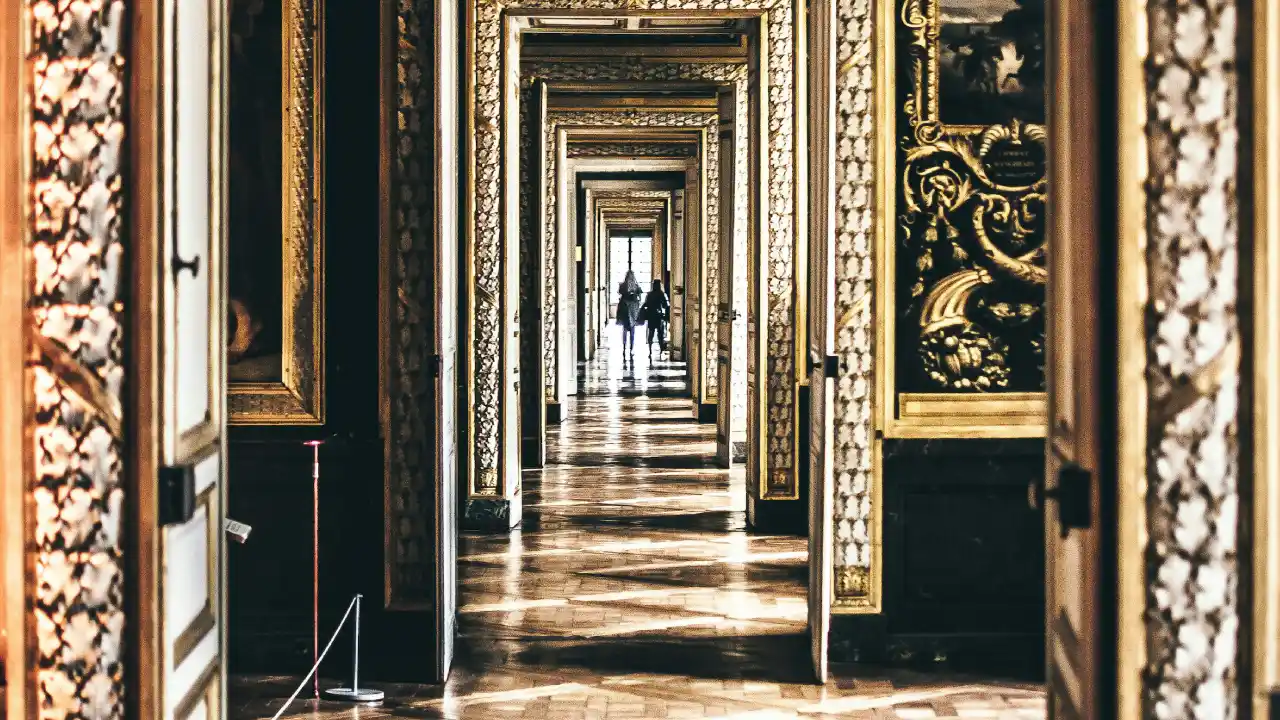
Customer support to help you with everything you need from 8.00 a.m. to 6.00 p.m.

Choose the best option for your needs and preferences and avoid the lines booking here

Enjoy art and history in Versailles, French monarchy’s masterpiece

The Palace of Versailles, located just outside Paris, France, stands as one of the most opulent and historically significant palaces in the world. Its grandeur, intricate architecture, and lush gardens attract millions of visitors each year. Here are twelve intriguing facts about this magnificent palace that shed light on its rich history and splendor.
One of the lesser-known features of the Palace of Versailles is its hidden library. This secret sanctuary is tucked away within the vast expanse of the palace, accessible through a concealed door. The library is filled with rare books, manuscripts, and documents that provide a glimpse into the intellectual pursuits of the French royalty. The hidden library was a place of solace and study for the kings and queens, a stark contrast to the public grandeur of the palace.
During the harsh winters, the grand canal of the Palace of Versailles transformed into an ice rink where the royals indulged in ice skating. This pastime was particularly popular during the reign of Louis XVI and Marie Antoinette. They and their courtiers would glide across the frozen surface, enjoying a winter sport that added a touch of joy to the cold season. This royal ice skating tradition highlights the more personal and leisurely aspects of life at Versailles.
The Palace of Versailles has a unique connection to modern sports, particularly the Tour de France. The palace and its gardens have occasionally been used as a starting or finishing point for stages of this prestigious cycling race. The scenic beauty and historical significance of Versailles provide a stunning backdrop for the cyclists, linking the grandeur of the past with the excitement of contemporary sporting events.
The gardens of Versailles once featured a famous labyrinth known as the Maze. Commissioned by Louis XIV, this intricate network of paths and hedges was designed to amuse and challenge visitors. The Maze was adorned with statues and fountains depicting scenes from Aesop’s Fables, making it not only a physical puzzle but also an educational experience. Unfortunately, the Maze was removed in the late 18th century, but its legacy remains a fascinating part of Versailles’ history.
The Hall of Mirrors, or Galerie des Glaces, is arguably the most famous room in the Palace of Versailles. This grand gallery stretches over 73 meters and features 357 mirrors that reflect the light from the seventeen large windows overlooking the gardens. The hall was designed by architect Jules Hardouin-Mansart and artist Charles Le Brun and was completed in 1684. It has hosted numerous significant events, including the signing of the Treaty of Versailles in 1919, which ended World War I.
The King’s Grand Apartments are a series of rooms that were used by Louis XIV for his daily activities and state functions. These rooms, including the King’s Chamber, the War Room, and the Peace Room, are lavishly decorated with elaborate frescoes, gilded moldings, and luxurious furnishings. Each room served a specific purpose, reflecting the rigid protocol and ceremonial life of the French court. The opulence of these apartments underscores the absolute power and divine right claimed by the Sun King.
Marie Antoinette, the last Queen of France before the French Revolution, had her own private estate within the grounds of Versailles. This estate included the Petit Trianon, a small chateau given to her by Louis XVI, and the Hameau de la Reine, a rustic retreat designed to resemble a peasant village. Here, Marie Antoinette could escape the formality of court life and indulge in simpler pleasures, such as gardening and hosting intimate gatherings. Her estate reflects her desire for personal freedom and privacy amidst the grandeur of Versailles.
The Royal Opera House, or Opéra Royal, is a stunning theater within the Palace of Versailles. Designed by architect Ange-Jacques Gabriel, it was completed in 1770 in time for the marriage of Louis XVI and Marie Antoinette. The Opera House is renowned for its exceptional acoustics, beautiful marble interiors, and intricate woodwork. It remains one of the finest examples of 18th-century theater architecture and continues to host performances, maintaining the cultural legacy of Versailles.
The gardens of the Palace of Versailles are as famous as the palace itself. Designed by landscape architect André Le Nôtre, the gardens cover nearly 2,000 acres and feature meticulously manicured lawns, parterres of flowers, ornate fountains, and sculptures. The Grand Canal, which stretches over 1.5 kilometers, is a central feature of the gardens. The layout of the gardens reflects the classical French style, emphasizing symmetry, order, and the harmonious relationship between nature and human artistry.
The Orangerie at Versailles is a large, elegant structure designed to house orange trees and other exotic plants during the winter months. Constructed between 1684 and 1686 by Jules Hardouin-Mansart, it features large windows and a heating system to protect the delicate plants from the cold. The Orangerie exemplifies the grandeur and attention to detail that characterize the entire palace complex. It is also used as a venue for special events and exhibitions, adding to its historical and cultural significance.
The fountain shows, or Grandes Eaux, are a spectacular feature of the Palace of Versailles’ gardens. These displays of water and music were originally designed to impress and entertain visitors during the reign of Louis XIV. The fountains, powered by a complex system of hydraulics, come to life in synchronized performances that enhance the beauty of the gardens. Today, the fountain shows continue to be a major attraction, drawing visitors from around the world to witness the interplay of water, art, and nature.
The Royal Chapel of Versailles, completed in 1710, is a masterpiece of Baroque architecture. It was the last major building project initiated by Louis XIV. The chapel features a stunning interior with a vaulted ceiling painted by Charles de La Fosse, intricate woodwork, and marble sculptures. The daily mass was an essential part of court life, and the chapel was the setting for significant events, including royal weddings and baptisms. Its architectural beauty and historical importance make it a key highlight of any visit to Versailles.
In conclusion, the Palace of Versailles is a testament to the grandeur and ambition of the French monarchy. Each of these twelve facts highlights a unique aspect of the palace’s rich history, architectural brilliance, and cultural significance. From hidden libraries to majestic gardens, the Palace of Versailles continues to captivate and inspire visitors with its timeless beauty and historical legacy.
The location of Versailles was formerly a small community with a church. In order to hu…
Given that Versailles is associated with Louis XIV and vice versa, Louis XIV appears to…
Louis XV, sometimes referred to as Louis the Beloved was formerly known as the King of…
Louis XVI became king at a young age when he was just around twenty years old…
